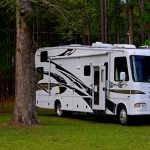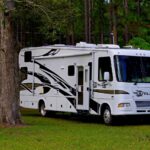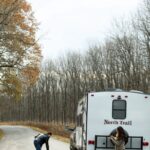Ever felt like your RV trips leave you more exhausted than refreshed? We’ve been there—chasing too many miles, arriving after dark, and barely catching our breath before hitting the road again. That’s when we discovered the 2 2 2 rule, a simple yet powerful travel mantra that transformed our RV adventures from frantic to fantastic. Curious how driving just 200 miles a day, arriving by 2 p.m., and staying two nights can make such a difference? Stick around, because this guide will unpack everything you need to know to travel smarter, safer, and with way more fun on the road.
Did you know that drowsy driving causes nearly 700 deaths annually in the U.S. alone? Following the 2 2 2 rule isn’t just about comfort—it’s about safety, sanity, and savoring every mile. Whether you’re a weekend warrior or a full-time RVer, mastering this rule can turn your next trip into a memorable journey instead of a stressful sprint.
Key Takeaways
- Drive no more than 200 miles or 2-3 hours daily to reduce fatigue and increase safety.
- Arrive at your campsite by 2 p.m. for stress-free setup and daylight exploration.
- Stay at least two nights per stop to rest, explore, and truly enjoy your destination.
- The 2 2 2 rule supports better sleep, mental wellness, and social connections on the road.
- Adapt the rule to fit your RV type and travel style for maximum enjoyment.
Ready to gear up for your next trip? Check out popular RV brands and trip planning tools to complement your 2 2 2 rule journey:
- Jayco RVs: RVShare | Outdoorsy | Jayco Official Website
- Forest River RVs: RVShare | Camping World | Forest River Official Website
- RV Trip Planning Tools: RV Trip Wizard | Roadtrippers
Table of Contents
- ⚡️ Quick Tips and Facts About the 2 2 2 Rule for RVing
- 🛠️ The Origins and Evolution of the 2 2 2 Rule in RV Travel
- 🔍 What Exactly Is the 2 2 2 Rule? Breaking Down the Basics
- 🚐 How the 2 2 2 Rule Enhances RV Safety and Comfort
- 📅 2 2 2 Rule in Practice: Planning Your RV Trip Like a Pro
- 🛏️ Sleeping Arrangements and Rest: The 2 2 2 Rule’s Impact on Your Zzz’s
- 🥾 Activity and Exploration: Maximizing Your RV Adventures with the 2 2 2 Rule
- 🍳 Meal Planning and Cooking Tips Aligned with the 2 2 2 Rule
- 💡 Common Misconceptions and Mistakes About the 2 2 2 Rule
- 🔧 Adapting the 2 2 2 Rule for Different Types of RVs and Travelers
- 🌟 Real-Life Stories: How We Used the 2 2 2 Rule to Transform Our RV Trips
- 🧳 Packing and Gear Tips to Complement the 2 2 2 Rule
- 📈 Benefits Beyond the Basics: Health, Mental Wellness, and Socializing on the Road
- 💬 Community Insights: What Other RVers Say About the 2 2 2 Rule
- 🎯 Tips for Customizing the 2 2 2 Rule to Fit Your Unique RV Lifestyle
- 📝 Conclusion: Why the 2 2 2 Rule Might Be Your New Best Friend on the Road
- 🔗 Recommended Links for Further RVing Wisdom
- ❓ Frequently Asked Questions About the 2 2 2 Rule
- 📚 Reference Links and Resources
⚡️ Quick Tips and Facts About the 2 2 2 Rule for RVing
Welcome to your ultimate guide on the 2 2 2 rule for RVing, brought to you by the RV enthusiasts at RV Brands™! If you’re new to RV travel or a seasoned road warrior, this simple yet powerful rule can transform your adventures from exhausting to exhilarating. Here’s the quick scoop:
- Drive no more than 200 miles or about 2-3 hours per day. This keeps you fresh and safe behind the wheel.
- Arrive at your campsite by 2 p.m. Early arrival means daylight for setup and exploring.
- Stay at least 2 nights at each stop. This helps you relax, explore locally, and reduces travel burnout.
Why does this matter? Because fatigue and stress are the silent trip killers on the road. Following this rule helps you avoid them and enjoy your journey more. Plus, it encourages a slower, more mindful travel pace that lets you soak in the scenery and local culture.
Quick Facts
| Aspect | Detail |
|---|---|
| Max daily driving | ~200 miles / 2-3 hours |
| Ideal arrival time | By 2 p.m. |
| Minimum stay duration | 2 nights |
| Benefits | Safety, relaxation, deeper exploration |
| Alternative rules | 3 3 3 Rule (300 miles, 3 p.m. arrival, 3 nights) |
For more on trip planning and avoiding common mistakes, check out our Full-Time RVing category and the insightful article on Used RV Statistics by Country: 7 Global Markets You Need to Know in 2025 🚐.
🛠️ The Origins and Evolution of the 2 2 2 Rule in RV Travel
The 2 2 2 rule didn’t just pop out of thin air—it evolved from decades of RVers’ collective wisdom. Early RV pioneers often pushed themselves too hard, driving long hours, arriving late, and bouncing from spot to spot without rest. This led to burnout, accidents, and missed experiences.
How It Came About
- Safety First: The rule emphasizes limiting driving time to reduce fatigue-related accidents. According to the National Highway Traffic Safety Administration, drowsy driving caused nearly 700 deaths in 2019 alone.
- Campground Courtesy: Arriving by 2 p.m. ensures you’re not rushing in the dark, which can disturb neighbors and complicate setup.
- Slow Travel Movement: Staying at least two nights aligns with the growing trend of slow travel, where quality trumps quantity.
Evolution to the 3 3 3 Rule
Some RVers prefer the 3 3 3 rule, extending daily driving to 300 miles, arriving by 3 p.m., and staying 3 nights. This offers more flexibility but still prioritizes safety and enjoyment.
The 2 2 2 rule remains a gold standard for beginners and those craving a relaxed pace.
🔍 What Exactly Is the 2 2 2 Rule? Breaking Down the Basics
Let’s unpack the 2 2 2 rule step-by-step so you can see why it’s such a game-changer.
1. Drive No More Than 200 Miles or 2-3 Hours Daily
- Why? Driving an RV is more demanding than a car. Longer drives increase fatigue and risk.
- How? Use apps like RV Trip Wizard or Google Maps to plan routes that keep you within this limit.
- Pro Tip: Schedule breaks every 1.5 to 2 hours to stretch, hydrate, and refuel.
2. Arrive at Your Campsite by 2 p.m.
- Why? Arriving early gives you daylight to set up, familiarize yourself with the area, and avoid the stress of rushing in the dark.
- How? Plan your departure times and stops accordingly. Factor in traffic and unexpected delays.
- Bonus: Early arrival often means better campsite choices!
3. Stay at Least 2 Nights Per Location
- Why? Staying put lets you rest, explore local attractions, and connect with fellow RVers.
- How? Book campsites for multiple nights or choose flexible sites with easy cancellation.
- Extra: This reduces wear and tear on your rig and your nerves!
🚐 How the 2 2 2 Rule Enhances RV Safety and Comfort
Safety and comfort are the pillars of enjoyable RV travel, and the 2 2 2 rule nails both.
Safety Benefits
- Reduced Fatigue: Limiting driving time lowers the risk of drowsy driving accidents.
- Better Setup: Arriving early means you’re not fumbling in the dark, which can cause injuries or equipment damage.
- Predictable Schedule: Staying two nights reduces the pressure to rush, allowing you to maintain alertness and energy.
Comfort Boosters
- Less Stress: No frantic last-minute campsite searches or hurried setups.
- More Rest: Two nights means you can unwind, sleep well, and recharge.
- Opportunity to Explore: You get time to hike, visit local spots, or just relax around your RV.
Our personal experience? After adopting the 2 2 2 rule on a cross-country trip in our Jayco Eagle Fifth Wheel, we noticed a dramatic drop in travel fatigue and a huge boost in enjoyment.
📅 2 2 2 Rule in Practice: Planning Your RV Trip Like a Pro
Ready to put the 2 2 2 rule into action? Here’s a step-by-step guide:
Step 1: Map Your Route in 200-Mile Segments
- Use tools like RV Trip Wizard or Roadtrippers to break your journey into manageable legs.
- Factor in terrain and road conditions; mountainous routes may require shorter distances.
Step 2: Book Campsites with Early Check-In or Flexible Arrival
- Aim for campgrounds that allow arrival by 2 p.m. or earlier.
- Reserve spots for at least two nights to avoid last-minute hassles.
Step 3: Schedule Breaks Every 2 Hours
- Plan stops at rest areas, gas stations, or scenic spots.
- Use breaks for stretching, snacking, and refueling.
Step 4: Build in Rest Days
- After a few travel days, consider a full rest day to explore or relax.
- This keeps energy levels high and spirits bright.
Step 5: Adjust for Weather and Road Conditions
- Check forecasts and road alerts to avoid driving in unsafe conditions.
- Be flexible—sometimes arriving earlier or staying longer is the smarter choice.
🛏️ Sleeping Arrangements and Rest: The 2 2 2 Rule’s Impact on Your Zzz’s
Sleep quality on the road can make or break your trip. The 2 2 2 rule supports better rest by:
- Limiting Driving Fatigue: Less time behind the wheel means you’re less likely to be wired or exhausted at bedtime.
- Allowing Time to Settle: Arriving early lets you set up your sleeping area calmly, without rushing.
- Encouraging Longer Stays: Staying two nights means you can adjust to new time zones or environments without sleep disruption.
Tips for Better Sleep on the Road
- Invest in blackout curtains and quality bedding.
- Use white noise machines or apps to drown out campground sounds.
- Maintain a consistent bedtime routine, even when traveling.
🥾 Activity and Exploration: Maximizing Your RV Adventures with the 2 2 2 Rule
The beauty of the 2 2 2 rule? It’s not just about driving less—it’s about living more.
- Explore Local Trails: With two nights, you can hike, bike, or take guided tours without rushing.
- Engage with Communities: Attend local events, farmers markets, or meet fellow RVers.
- Try New Experiences: Fishing, kayaking, or visiting museums become feasible and fun.
Our friends at Drivin’ Vibin’ echo this sentiment, noting how the rule “gives you time to see a local point of interest or hike a trail to burn off some of the pent-up energy.”
🍳 Meal Planning and Cooking Tips Aligned with the 2 2 2 Rule
Staying put for two nights means you can plan meals more efficiently and enjoy cooking in your RV kitchen.
Benefits
- Less Food Waste: Buying fresh local ingredients for two days reduces spoilage.
- More Time to Cook: No need to rush meals between travel stops.
- Opportunity to Try Local Cuisine: Visit local markets or restaurants.
Tips
- Plan simple, nutritious meals that don’t require excessive prep.
- Stock up on staples like canned beans, pasta, and spices.
- Use slow cookers or Instant Pots to make hands-off meals.
💡 Common Misconceptions and Mistakes About the 2 2 2 Rule
Let’s bust some myths and avoid pitfalls:
Myth 1: The 2 2 2 Rule Is Too Slow for Adventurous RVers
❌ False! It’s about quality, not speed. You’ll see more by staying longer and traveling smarter.
Myth 2: You Must Rigidly Follow the Rule Every Day
❌ Nope! Flexibility is key. The rule is a guideline, not a mandate.
Mistake: Ignoring Weather and Road Conditions
❌ Always adjust your plans if conditions change. Safety first!
🔧 Adapting the 2 2 2 Rule for Different Types of RVs and Travelers
Not all RVs or travelers are created equal. Here’s how to tweak the rule:
| RV Type | Suggested Adaptation | Why? |
|---|---|---|
| Class A Motorhomes | May prefer shorter drives due to size | Maneuverability and fuel consumption |
| Travel Trailers | Stick to 2 2 2 for safety | Tow vehicle fatigue and setup time |
| Full-Time RVers | May extend to 3 3 3 occasionally | More experience and comfort on the road |
| Families with Kids | Emphasize breaks and longer stays | Kids need downtime and routine |
🌟 Real-Life Stories: How We Used the 2 2 2 Rule to Transform Our RV Trips
We remember our first big trip in a Forest River Rockwood Fifth Wheel. We tried to cover 400 miles a day and arrived after dark. Result? Frazzled nerves, missed turns, and a cranky crew.
After switching to the 2 2 2 rule, everything changed. We arrived by 2 p.m., set up camp with daylight to spare, and enjoyed local hikes and campfire chats. The kids slept better, and we felt more connected to the places we visited.
🧳 Packing and Gear Tips to Complement the 2 2 2 Rule
Since you’ll be staying put longer, pack smart:
- Bring versatile clothing for varying weather.
- Stock up on entertainment like books and games for downtime.
- Carry quality camping gear for outdoor activities.
- Don’t forget essential tools and a first aid kit (see our RV Trip Planning Mistakes for more).
📈 Benefits Beyond the Basics: Health, Mental Wellness, and Socializing on the Road
The 2 2 2 rule isn’t just about logistics—it’s a lifestyle enhancer.
- Better mental health: Less stress and more time to relax.
- Physical wellness: Regular breaks and local activities keep you active.
- Social connections: Longer stays foster friendships with locals and fellow RVers.
💬 Community Insights: What Other RVers Say About the 2 2 2 Rule
We scoured forums, blogs, and social media to hear from the RV community:
- Larry from the Brazen Brits says, “Driving 6-7 hours was exhausting. The 2 2 2 rule helped us slow down and enjoy the journey.”
- Danny Spain of RV America follows the “Rule of 3” but agrees the 2 2 2 rule is perfect for beginners.
- Many RVers praise the rule for reducing burnout and improving safety.
🎯 Tips for Customizing the 2 2 2 Rule to Fit Your Unique RV Lifestyle
No two RVers are alike! Here’s how to make the rule your own:
- Adjust driving distance based on your comfort and rig size.
- Shift arrival time if your campground has different check-in policies.
- Extend stays if you want deeper exploration or rest.
- Mix in rest days after several travel days for ultimate recharge.
👉 Shop Popular RV Brands and Gear to Enhance Your 2 2 2 Rule Experience:
- Jayco RVs: RVShare | Outdoorsy | Jayco Official Website
- Forest River RVs: RVShare | Camping World | Forest River Official Website
- RV Trip Planning Tools: RV Trip Wizard | Roadtrippers
Ready to hit the road smarter and safer? The 2 2 2 rule is your trusty co-pilot for memorable RV adventures! 🚐💨
🏁 Conclusion: Why the 2 2 2 Rule Might Be Your New Best Friend on the Road
So, what’s the final word on the 2 2 2 rule for RVing? After diving deep into its origins, benefits, and real-world applications, it’s clear this simple guideline is a game-changer for both novice and experienced RVers. By limiting your daily drive to about 200 miles, arriving early at your campsite, and staying at least two nights, you’re not just following a rule—you’re embracing a mindset that prioritizes safety, relaxation, and meaningful exploration.
Remember our personal story about the rocky first trip? The 2 2 2 rule saved us from burnout and turned our travels into a series of memorable, enjoyable experiences. It’s not about rushing to check off destinations but savoring each stop, connecting with nature and community, and keeping your rig—and yourself—in tip-top shape.
If you’re wondering whether to stick rigidly to the rule or adapt it, our advice is: be flexible but mindful. The 2 2 2 rule is a foundation, not a cage. Customize it to your rig, your family, and your travel style, and you’ll find it enhances your RV lifestyle immensely.
Ready to hit the road with confidence? The 2 2 2 rule is your trusty co-pilot for safer, happier, and more fulfilling RV adventures. Happy trails! 🚐✨
🔗 Recommended Links for Further RVing Wisdom
👉 Shop Popular RV Brands and Gear to Enhance Your 2 2 2 Rule Experience:
- Jayco RVs: RVShare | Outdoorsy | Jayco Official Website
- Forest River RVs: RVShare | Camping World | Forest River Official Website
- RV Trip Planning Tools: RV Trip Wizard | Roadtrippers
Books to Deepen Your RV Knowledge:
- The RV Handbook: Essential How-To Guide for the RV Owner by Dave Solberg — Amazon Link
- The Complete RV Handbook: A Guide to Buying, Maintaining, and Enjoying Recreational Vehicles by Bill Moeller — Amazon Link
- RV Vacations For Dummies by Bob Borson — Amazon Link
❓ Frequently Asked Questions About the 2 2 2 Rule
What are the essential items to pack for a comfortable RVing experience?
Packing smart is key to a smooth RV trip. Essentials include:
- Safety gear: First aid kit, fire extinguisher, tire pressure gauge.
- Comfort items: Quality bedding, blackout curtains, portable fans or heaters.
- Cooking supplies: Portable grill, slow cooker, basic utensils, and reusable containers.
- Outdoor gear: Folding chairs, hiking boots, insect repellent, and sunscreen.
- Tech: GPS or RV-specific navigation apps, chargers, and backup batteries.
- Tools: Basic toolkit, leveling blocks, spare fuses, and hoses.
Packing these ensures you’re prepared for most situations, enhancing your comfort and safety on the road.
How do I plan an RV trip with multiple destinations and activities?
Planning a multi-stop RV trip involves:
- Route segmentation: Break your journey into manageable legs, ideally following the 2 2 2 rule or your preferred variation.
- Campsite reservations: Book sites in advance, especially during peak seasons, and confirm check-in policies.
- Activity scheduling: Prioritize must-see spots and allow downtime for rest and spontaneous adventures.
- Flexibility: Build in buffer days for weather delays or unexpected discoveries.
- Resource planning: Map fuel stops, dump stations, and grocery stores along the way.
Using tools like RV Trip Wizard or Roadtrippers can simplify this process.
What are some common mistakes to avoid when RVing for the first time?
Avoid these rookie errors:
- Overpacking: Excess weight affects fuel economy and handling. Pack light and smart.
- Ignoring vehicle dimensions: Know your RV’s height and length to avoid low bridges or tight turns.
- Driving too long: Follow the 2 2 2 rule to prevent fatigue.
- Not making reservations: Especially in popular areas, this can leave you stranded.
- Skipping test runs: Practice driving and setting up your rig before long trips.
- Neglecting maintenance: Check tires, brakes, and fluids regularly.
For a comprehensive list, see Common RV Trip Planning Mistakes – Crossroads Blog.
What are the best RVing routes and destinations for beginners in the United States?
Great starter routes include:
- Blue Ridge Parkway (VA & NC): Scenic, manageable distances, and plenty of campgrounds.
- Pacific Coast Highway (CA): Stunning views with well-equipped RV parks.
- Great Smoky Mountains (TN & NC): Family-friendly with lots of outdoor activities.
- Route 66: Classic Americana with historic stops and RV-friendly sites.
- Florida Keys: Warm weather, beautiful beaches, and easy driving.
These routes offer a balance of accessibility, amenities, and unforgettable experiences for new RVers.
📚 Reference Links and Resources
- National Highway Traffic Safety Administration (NHTSA) on drowsy driving statistics: https://www.nhtsa.gov/risky-driving/drowsy-driving
- Jayco Official Website: https://www.jayco.com/
- Forest River Official Website: https://forestriverinc.com/
- RV Trip Wizard: https://rvtripwizard.com/
- Roadtrippers: https://roadtrippers.com/
- Drivin’ Vibin’ article on the 2 2 2 rule: https://drivinvibin.com/2023/12/19/rv-2-2-2-rule/
- Cozy Camper ATX on understanding the 2 2 2 and 3 3 3 rules: https://www.cozycamperatx.com/post/cracking-the-code-understanding-the-rv-222-and-333-rule
- Common RV Trip Planning Mistakes – Crossroads Blog: https://www.crossroadstrailers.com/blog/rv-trip-planning-mistakes/
Feel free to explore these resources to deepen your RV knowledge and make your next trip your best yet!




